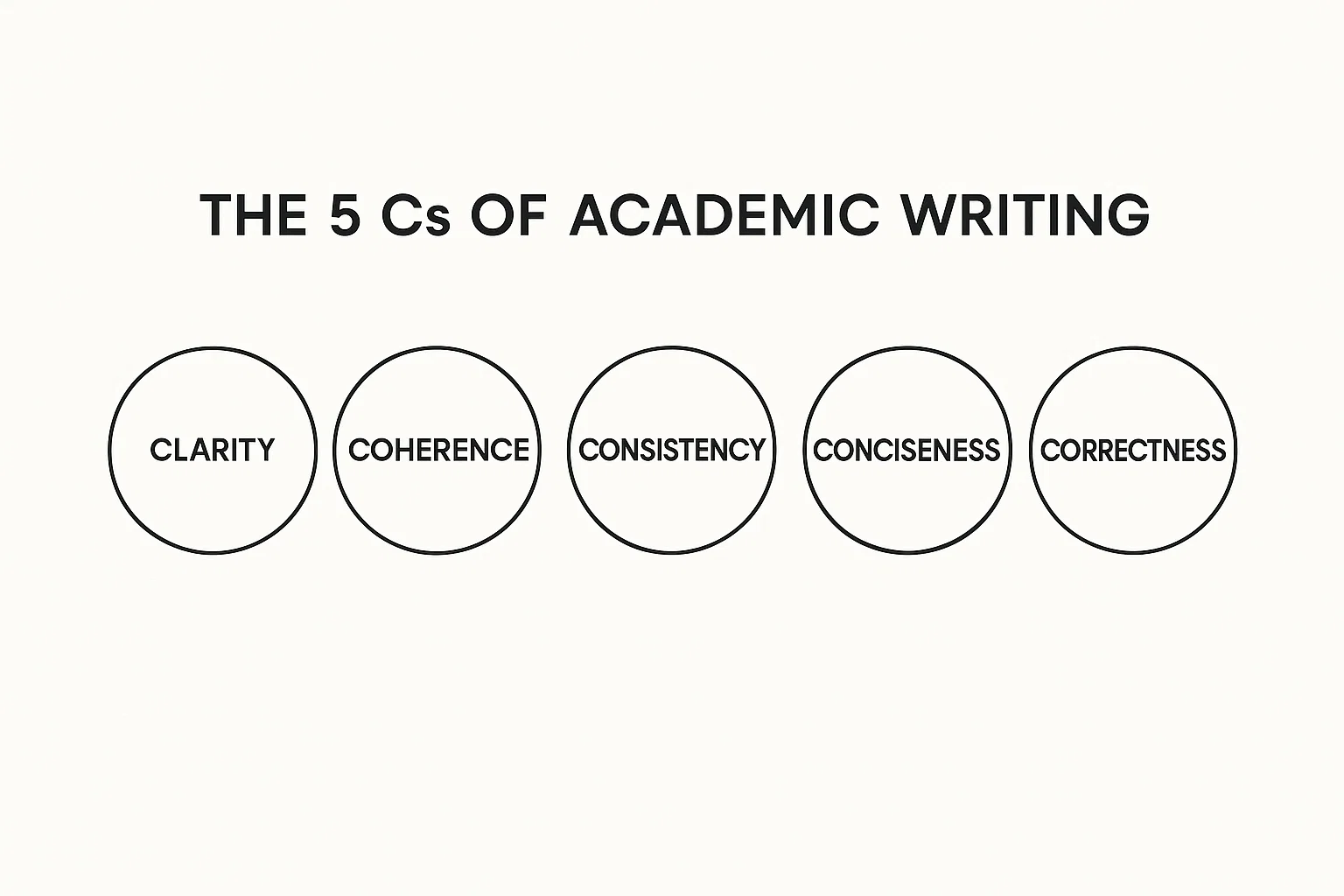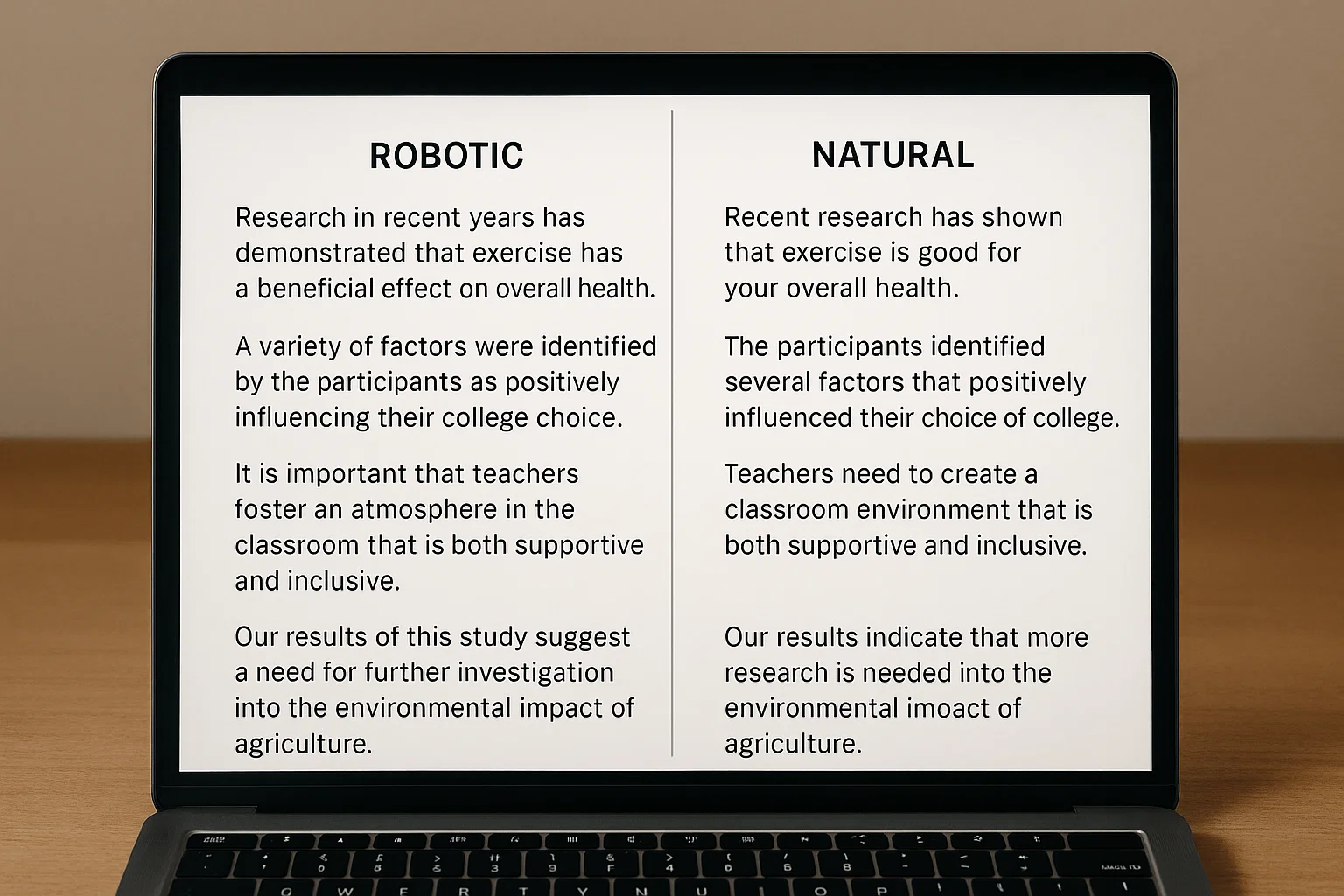That’s what happens when we confuse academic with impersonal. The truth is, academic voice isn’t about sounding stiff; it’s about sounding clear, credible, and confident three things both human and AI writers can achieve with the right mindset and tools.
Whether you’re drafting a university paper or fine-tuning your AI prompt, learning to use academic voice without losing your natural rhythm is one of the most useful writing skills you’ll ever build.
Let’s unpack how to do that together.
What “Academic Voice” Really Means
At its core, an academic voice is a writing style that conveys authority and thoughtfulness. It shows readers that your ideas are based on reason and evidence, not emotion or bias.
But here’s the secret most guides forget to mention: clarity beats complexity every time.
An academic voice is not about stuffing your work with long sentences or fancy words. It’s about writing with purpose. It sounds informed, not inflated.
Think of it this way:
| Weak & Stiff | Natural & Academic |
|---|---|
| “It can be seen that the results were negatively impacted due to certain circumstances.” | “The results declined because of unexpected conditions.” |
Both say the same thing, but the second one respects your reader’s time and still sounds scholarly.
When AI tools like ChatGPT or Grammarly’s formal tone setting are used wisely, they can suggest structure and vocabulary without making your work robotic. The trick is to stay in charge of the voice, not let the software dictate it.
Why Writers Become Too Stiff
There’s a psychological reason many writers especially students drift toward stiffness. We’re taught early on that “academic” equals “serious,” and “serious” equals “big words.”
That’s how you end up writing like a rulebook instead of a researcher.
Here are the most common causes:
- Fear of sounding wrong – Writers overcompensate by using jargon.
- Overuse of passive voice – “The experiment was conducted by the researcher” sounds distant.
- Copying academic models blindly – Mimicking journal tone without adapting it to purpose.
- AI over-polishing – Using rewriting tools that strip out natural rhythm in favor of sterile precision.
The result? Text that’s grammatically flawless but emotionally flat.
A good academic voice should feel like a calm, intelligent conversation, not a lecture from a robot.
The 5 C’s of Academic Writing Without the Coldness
If you’ve ever read about academic writing frameworks, you’ve likely encountered the 5 C’s:
Clarity, Coherence, Consistency, Conciseness, and Correctness.
They’re excellent pillars but only when treated as guidelines, not iron cages.
Let’s give them a human spin.
- Clarity – Write so your reader gets it the first time. Replace heavy nominalizations (“utilization”) with everyday equivalents (“use”).
- Coherence – Flow matters. Each sentence should connect logically, like links in a chain.
- Consistency – Stay steady with tense, point of view, and terminology. But remember: consistency doesn’t mean monotony. Vary sentence length to keep rhythm alive.
- Conciseness – Trim filler words. Yet don’t mistake short for soulless brevity still allows style.
- Correctness – Grammar and citation accuracy matter. But over-editing can bleach your personality; perfectionism is not a requirement for professionalism.
Even AI writers benefit from this checklist. Tools like Quillbot or Spinbot can help condense or clarify sentences, but you should always reread the output aloud. Your ears will tell you if the tone still sounds like you.
Passive Voice: Friend or Foe?
You’ve probably been told to “avoid passive voice.”
But is it really that bad?
Let’s clarify: passive voice is not evil it’s strategic.
It simply shifts focus from who did it to what happened.
Example:
- Passive: “The samples were tested using a spectrometer.”
- Active: “Researchers tested the samples using a spectrometer.”
Both are correct. The first emphasizes the process, the second the people.
In scientific or technical writing, passive voice often keeps attention on the method rather than the researcher. In reflective essays, however, active voice keeps the tone lively and direct.
So, the rule isn’t avoid passive voice. It’s use it consciously.
Even when you ask an AI model to rewrite something “in academic tone,” specify your intention:
“Make it formal but keep active voice where possible.”
That small instruction can prevent your writing from sounding detached.
The Three Key Elements of Academic Voice
Now, let’s zoom in on what truly defines an academic tone beyond grammar and vocabulary.
These three elements separate professional writing from casual commentary.
1. Objectivity
Academic writing relies on evidence, not personal bias. That doesn’t mean you erase your opinion it means you back it up.
Instead of saying, “I believe social media harms productivity,” you can write, “Research indicates that social media use correlates with reduced productivity.”
Notice how the voice stays confident but impersonal.
2. Precision
Avoid vague phrases like “some people think” or “a lot of studies.” Quantify and specify. If you’re using AI to help draft, ask it to insert exact numbers, data sources, or clear qualifiers.
Prompt tip: “Rewrite this paragraph with more precise verbs and remove vague quantifiers.”
Precision strengthens your credibility.
3. Evidence-Based Reasoning
Each claim should have a reason or reference.
Humans sometimes forget; AI models sometimes fabricate. That’s why you, the human editor, remain the guardian of truth. Always verify AI-generated data before trusting it in academic work.
The Difference Between Academic and Personal Voice
Think of academic voice as a professional outfit it’s polished, reliable, and neutral.
Your personal voice, on the other hand, is your natural way of speaking. It’s what gives your writing warmth and authenticity.
The sweet spot lies where these two meet. You can write academically with personality.
Example:
Too personal: “I think climate change is terrifying and we should all panic.”
Too academic: “The global climate crisis constitutes an existential threat to contemporary ecosystems.”
Balanced: “Climate change poses a serious threat to global ecosystems, prompting urgent action worldwide.”
That middle ground communicates concern and credibility.
AI tools can help you hit that balance if you steer them with intent. Ask your model to “maintain academic tone but preserve human empathy.” You’ll notice the difference instantly.
How AI Can Help You Sound Smart, Not Stiff
AI writing tools can be your best ally or your worst enabler.
Used thoughtfully, they enhance consistency and clarity. Used blindly, they drain personality.
Here’s how to get the best of both worlds:
1. Draft Freely, Edit Formally
Start with your natural voice. Let ideas flow as if you’re explaining them to a friend.
Then, use AI to polish structure, syntax, and transitions. This order matters if you start formal, you’ll never loosen up.
2. Prompt for Tone, Not Perfection
Instead of “Rewrite this academically,” try:
“Rewrite this for academic readers but keep it natural, varied, and conversational.”
You’ll get smoother, human-sounding output.
3. Check Rhythm
Ask AI to vary sentence lengths or reduce repetitive patterns. Academic papers often sound robotic because every sentence follows identical structure.
AI can detect and diversify that.
4. Use Tools That Analyze Voice
Platforms like Grammarly’s tone detector, Writer.com, or Hemingway Editor now highlight formality level and readability.
Use those metrics to balance professionalism with flow.
5. Never Skip the Human Pass
No matter how advanced your writing assistant is, always read the final version aloud.
If it feels like someone lecturing at a conference podium instead of a person sharing insight, it’s time to soften the edges.
Common Mistakes When Using AI for Academic Voice
| Mistake | What Happens | Quick Fix |
|---|---|---|
| Over-prompting for “formal tone” | Output becomes mechanical | Add “keep it conversational and concise” to your prompt |
| Blindly accepting rewrites | AI introduces awkward phrasing | Manually re-check sentence rhythm |
| Over-using jargon | Sounding elitist or vague | Replace with simpler terms |
| Ignoring context | Misaligned tone for audience | Specify the target reader (professor, journal, peer) |
Think of AI as your writing assistant, not your ghostwriter. It works best when guided with clarity.
How to Humanize AI-Generated Academic Writing
When you get an AI draft that reads well but feels empty, these small tweaks can bring it to life:
- Add Transition Words
Words like “however,” “in contrast,” “for example,” or “more importantly” connect ideas smoothly. - Use Active Verbs
Replace “is conducted” with “conducts,” “was analyzed” with “analyzed.” - Insert Micro-Examples
Instead of abstract theories, use quick illustrations AI can help generate them, but personalize them with your voice. - Balance Formality with Warmth
Phrases like “It’s worth noting that…” soften transitions while staying academic. - Adjust Readability
Use a readability checker to ensure your text sits between Grade 8–12 for general academic audiences.
Examples: From Robotic to Natural Academic Tone
Let’s compare a few real-world rewrites to see what “unstiffening” looks like.
Example 1
Robotic:
“The experiment was conducted to determine the effects of temperature on enzyme activity, and the data were analyzed using statistical software.”
Natural Academic:
“We examined how temperature influences enzyme activity and analyzed the data statistically.”
Cleaner, more direct, yet fully formal.
Example 2
Robotic:
“It is believed by many scholars that social interaction has a significant influence upon language development.”
Natural Academic:
“Many scholars argue that social interaction strongly shapes language development.”
The voice shifts from distant to dynamic.
Example 3
Robotic (AI default):
“The implementation of sustainable policies is a critical component in addressing the challenges posed by global climate change.”
Humanized Rewrite:
“Implementing sustainable policies plays a crucial role in tackling global climate challenges.”
Same content less friction.
Building Your Own Academic Voice
Your academic voice isn’t a template; it’s a skill you shape over time.
Here’s a simple practice routine (for humans and AI users alike):
- Collect Sentences You Admire
From journals, professors, or even good AI drafts. Analyze why they flow well. - Rewrite in Your Own Words
Keep structure, change language. This builds fluency. - Train AI on Your Tone
Feed the model examples of your preferred writing style. Tools like ChatGPT memory or custom GPTs can adapt to your phrasing. - Reflect After Feedback
Every time someone edits your work, note what they change and why. - Revisit the 5 C’s Often
Make clarity your compass.
Over time, your voice will feel naturally balanced academic but approachable.
Quick Reference: Do’s and Don’ts
Do:
- Use active voice whenever it clarifies meaning.
- Vary sentence length and structure.
- Support claims with credible evidence.
- Use AI tools for polishing, not personality replacement.
- Aim for confidence, not complexity.
Don’t:
- Over-stuff with jargon or passive phrasing.
- Treat AI output as finished work.
- Equate long sentences with intelligence.
- Forget your reader’s perspective.
Final Reflection: Sound Smart, Not Stiff
Academic voice is a tool for clarity and credibility, not a straightjacket.
Whether you’re writing alone or collaborating with AI, your goal is the same: make your thinking shine through language that’s precise, persuasive, and alive.
Every polished essay, research report, or AI-generated paragraph is a chance to prove that intelligence can sound human.
So, write boldly. Edit wisely. And remember being professional doesn’t mean being cold.
Because the smartest writing is the kind that sounds like it came from a real mind, not just a perfect machine.

AI writing strategist with hands-on NLP experience, Liam simplifies complex topics into bite-sized brilliance. Trusted by thousands for actionable, future-forward content you can rely on.



